Cubic Shaping of Lattice Constellations from Multi-Level Constructions from Codes †
Abstract
1. Introduction
2. Preliminary Information
2.1. Quadratic Ring of Integers
- Either and B is prime or are pairwisely coprime.
- .
- .
2.2. Constructions of Lattices from Linear Codes
- (Code Formula) is defined as , where
- (Construction D) is defined as , where
2.3. Tileability
3. Cubic Shaping of
3.1. Introductory Theorems in Tileability
- Suppose that is not bijective. This means that there exist two distinct elements such that . Suppose that a and b are with coefficients , respectively. We define , which will have coefficients where . Since a and b are distinct, it follows that ’s are not all zero.However, we have . By considering the real and imaginary parts of the equation, which are under modulo w and , respectively, together with the fact that , one obtains and as desired.
- Suppose that there exists an element d with coefficients , where ’s are not all zero and such that and . Next, we separate the coefficients of d into positive and negative ones and use them to construct such a and b. DefineSince the coefficients of a and b are in , . It is obvious that , and from the fact that together with the property that and , one may combine the real and imaginary parts into one equation, namely, . This concludes that is not bijective.
- 1.
- For any w, the bijectivity of for and is the same.
- 2.
- If m is even, the bijectivity of for , , , and is the same.
- Suppose that for is not bijective. According to Proposition 3, there exists an element d with coefficients , where ’s are not all zero and such that and .We construct a counterexample for by introducing an element with coefficients for all . From the definition, we can see that ’s are not all zero with . Furthermore,Therefore, and as well. From Proposition 3, it implies that is not bijective for .
- Suppose that m is even. It now suffices to show that the bijectivity of for and coincides.Suppose that is not bijective for . From Proposition 3, there exists an element d with coefficients , where ’s are not all zero and such that and are both divisible by .We construct a counterexample again, this time with employing the same coefficients. In other words, , implying that . Nonetheless, it follows from that . As a result,Since and are divisible by , so are and .
3.2. Totally Tiling Bases
- For m even, we use . Since is the componentwise modulo on the real and imaginary parts, for any , for some . Therefore,The equation shows that is the p-ary decomposition through base , which is unique.
- For m odd, we use and . Similarly, for any ,for some . As a result,This p-ary decomposition base is unique as long as is also uniquely represented. Here, its real and imaginary parts are and , which are then both uniquely represented, since and .
- For , we have .
- For , we have .
- For , we have .
- For , we use . Because is componentwise modulo on both real and imaginary parts, for any , for some . Consequently,which is the binary decomposition base , and is unique.
- For , we use and . Therefore, for any ,for some . As a result,From the uniqueness property of binary decomposition base , it is left to show that the term is uniquely represented. Here, its real and imaginary parts are and , and so the uniqueness of the expressions ensues from the fact that and .
- For , we use and . For any , we can write the tiling map asfor some . This implies thatBy applying the same technique as in the previous case, we conclude that it is uniquely represented.
- For , we use . Hence, for any element , we have for some . It can be rewritten aswhich is a ternary decomposition base and is unique.
- For , we use and . For any element , we have for some . Therefore,We invoke unique decomposition base , and it remains to be shown that is uniquely represented. By considering its real part, we have , which is uniquely represented via division modulo and that . Furthermore, its imaginary part is , which is uniquely represented.
- For , the first possibility is and . For , we have for some . Therefore,Again, it is only left to show that the term is uniquely represented. Notice thatSince is a free -module which can be generated by 1 and , we have that the expressions and are uniquely represented. However, the first term is uniquely represented by and , since and . As a result, must be unique as well.
- For , the second possibility is and . For any , for some . Then,In this case, we are left to show that is uniquely represented. Since its real part is , where and , it is uniquely represented by and . From the uniqueness of , it follows that must be unique, in order to make unique.
- For , we use and . For any element , for some . Hence,Lastly, it is left to show that is uniquely represented by and . Notice thatWe once again use the fact that is a free -module generated by 1 and to conclude that the expressions and are unique. Since and , the first term is uniquely represented by and . Consequently, is unique as well.
3.3. Counterexamples for the Remaining Cases
- On , for with norm , we have .
- On , for with norm , we have .
- On , for with norm , we have .
- For , , and , it is obvious that they obey .
- For , suppose on the contrary that . The inequality can be written as a polynomial inequality in x aswhose discriminant is . The inequality holds if and only if the discriminant is non-negative, which means that . Since , we can conclude that . As for the next step, we consider whether or .
- –
- When , we have the ring . The inequality of discriminant is . Therefore, , and thus . The only possible bases are , , which have already been given a counterexample.
- –
- When , we have the ring . The inequality of discriminant is . As a result, we have and or and . The resulting bases are . However, each of them either has norm or has been given a counterexample previously.
- For with norm , we use as a counterexample.
- For other bases, we take , , , and , which gives us . Again, we have yet to verify that the coefficients obey .
- –
- It is clear that and satisfy .
- –
- For , we have . The only case of equality is when . This would imply where a counterexample has already been constructed.
- –
- For , we have as desired.
- For and the base with norm , we use as a counterexample.
- Suppose that . According to Lemma 2, either or . Therefore, the only possible value for b is 1, and thus . This leads to the bases with norm in . For the base , we choose as a counterexample.
- Suppose that . We choose , , , and , which yields . It is left to show that the coefficients satisfy .
- –
- It is clear that and follow .
- –
- The inequality is equivalent to either , which is true by the assumption, or , which is always true for all and . Hence, .
- –
- For , we suppose on the contrary that , which is equivalent to a polynomial inequality in x as follows:The inequality has a solution if and only if the discriminant of the polynomial is non-negative, meaning that . The only solutions to this inequality where are . Here, contradicts Lemma 2 and implies with norm in , both of which are not in consideration.
- Suppose that . We choose , , , and , which gives . Again, we show next that for all ’s.
- –
- The statement is clear for and .
- –
- For , the inequality is equivalent to either , which is always the case for all and , or , which is true from the assumption. Thus, .
- –
- For , we suppose on the contrary that , which can be written as a polynomial inequality in x asSimilar to the previous case, the discriminant is non-negative when . For to satisfy the inequality, the only solutions are . Once again, contradicts Lemma 2. The solutions give the following bases.
- –
- For , in . Each of them either fails or .
- –
- For , in , where . Each of them either fails or or has already been given a counterexample.
- –
- For , in where . They both fail the assumption .
Lastly, the solutions give bases in , and they all fail to satisfy . We conclude that .
- First, we show that implies or , and that implies or .
- –
- Suppose that . Since t is an integer, must be divisible by p. However, , and so we have . As a result, . Because and , it follows that , which eventually implies that or p.
- –
- Suppose that . Because t is an integer, must be divisible by p. Due to the fact that and , we obtain , and thus or p.
Therefore, if or is equal to p, the other one must be either 0 or p. This takes us to the next step of the proof. - We show that are all impossible.
- –
- Suppose that and . It follows that . Unfortunately, and , meaning that t is not an integer, which is a contradiction.
- –
- Suppose that and . It follows that . Again, and , and so t is not an integer, which is a contradiction.
- –
- Suppose that . It follows that . Because and , is an integer if and only if is divisible by p. Since , it implies , or equivalently . The only solutions here are . Excluding those from the family of known tiling bases, we are left with the following bases, for which we now provide a counterexample.
- –
- For in with norm , we have .
- –
- For in with norm , we have .
We have shown that and , thus guaranteeing the existence of a counterexample, and the proof is now complete.
- If , we have , or equivalently . However, , and so . Since p is a prime, . Because , we have , or . The existence of solutions occurs when , and they are . These solutions only produce bases of norms or .
- If , the inequality implies that , and thus .
- Suppose that , or . Notice that . According to Theorem 1, it is sufficient to show the case , whose norm is . Here, we choose as a counterexample, which implies that is not bijective.
- Suppose that . Since and ,This inequality simplifies to either or . When x is considered a variable, the discriminant of these inequalities is either or . We can omit the case since an inequality with a negative discriminant cannot have a real solution. On the other hand, if , then a solution exists only when , and they are . These solutions give bases of norm .
- We show that implies or , and that implies or
- –
- Suppose that . Since t is an integer, is divisible by p. However, by the fact that , we have that . As a result, . From and , we have , which means that or p.
- –
- Suppose that . Since s and t are integers, and are divisible by p. Hence, is divisible by p. Since , must then be divisible by p. This, however, makes divisible by p. Since and , we conclude that , implying or p.
- We show that are impossible.
- –
- Suppose that and . It follows that and . Because s and t are integers and , and must both be divisible by p. This implies that p divides , contradicting the fact that and .
- –
- Suppose that and . It follows that . Since and , it contradicts the fact that t is an integer.
- –
- Suppose that . It follows thatBecause are integers and , we haveFrom these equations, we obtain . Since and , we have , which is a contradiction. This finishes the last piece of the theorem.
4. Summary and Application
- The trivial in where and B is prime,
- The trivial in , where and is prime,
- in ,
- in .
- For where and B is prime, the norm is , and .
- For where and is prime, the norm is , and .
- For , the norm is . Here, if , then , and if , then .
- For , the norm is . If , then , and if , then .
Author Contributions
Funding
Data Availability Statement
Conflicts of Interest
References
- Urbanke, R.; Rimoldi, B. Lattice codes can achieve capacity on the AWGN channel. IEEE Trans. Inf. Theory 1998, 44, 273–278. [Google Scholar] [CrossRef]
- Bos, J.; Ducas, L.; Kiltz, E.; Lepoint, T.; Lyubashevsky, V.; Schanck, J.M.; Schwabe, P.; Seiler, G.; Stehlé, D. CRYSTALS–Kyber: A CCA-Secure Module-Lattice-Based KEM. In Proceedings of the 2018 IEEE European Symposium on Security and Privacy (EuroS&P), London, UK, 24–26 April 2018; pp. 353–367. [Google Scholar] [CrossRef]
- Post-Quantum Cryptography, National Institute of Standards and Technology. Available online: https://www.nist.gov/pqcrypto (accessed on 3 April 2025).
- Richter, M.; Bertram, M.; Seidensticker, J.; Tschache, A. A mathematical perspective on post-quantum cryptography. Mathematics 2022, 10, 2579. [Google Scholar] [CrossRef]
- Conway, J.H.; Sloane, N.J.A. Sphere Packings, Lattices and Groups; Springer Science & Business Media: Berlin/Heidelberg, Germany, 2013; Volume 290. [Google Scholar]
- Bollauf, M.F.; Zamir, R.; Costa, S.I.R. Multilevel Constructions: Coding, Packing and Geometric Uniformity. IEEE Trans. Inf. Theory 2019, 65, 7669–7681. [Google Scholar] [CrossRef]
- Zhou, F.; Kurkoski, B.M. Construction D′ lattices for power-constrained communications. IEEE Trans. Commun. 2022, 70, 2200–2212. [Google Scholar] [CrossRef]
- Matsumine, T.; Kurkoski, B.M.; Ochiai, H. Construction D lattice decoding and its application to BCH code lattices. In Proceedings of the 2018 IEEE Global Communications Conference (GLOBECOM), Abu Dhabi, United Arab Emirates, 9–13 December 2018; pp. 1–6. [Google Scholar]
- da Silva, P.R.B.; Silva, D. Multilevel LDPC lattices with efficient encoding and decoding and a generalization of construction D′. IEEE Trans. Inf. Theory 2018, 65, 3246–3260. [Google Scholar] [CrossRef]
- Forney, G.D. Coset codes. Introduction and geometrical classification. IEEE Trans. Inf. Theory 1988, 34, 1123–1151. [Google Scholar] [CrossRef]
- Hannusch, C. On monomial codes in modular group algebras. Discret. Math. 2017, 340, 957–962. [Google Scholar] [CrossRef]
- Hong, J.; Rasool, A.; Wang, S.; Ziou, D.; Jiang, Q. VSD: A Novel Method for Video Segmentation and Storage in DNA Using RS Code. Mathematics 2024, 12, 1235. [Google Scholar] [CrossRef]
- Reed, I.S.; Solomon, G. Polynomial codes over certain finite fields. J. Soc. Ind. Appl. Math. 1960, 8, 300–304. [Google Scholar] [CrossRef]
- Wicker, S.B.; Bhargava, V.K. Reed-Solomon Codes and Their Applications; John Wiley & Sons: Hoboken, NJ, USA, 1999. [Google Scholar]
- Kositwattanarerk, W.; Ong, S.S.; Oggier, F. Construction A of lattices over number fields and block fading (wiretap) coding. IEEE Trans. Inf. Theory 2015, 61, 2273–2282. [Google Scholar] [CrossRef]
- Khodaiemehr, H.; Panario, D.; Sadeghi, M.-R. Design and practical decoding of full-diversity Construction A lattices for block-fading channels. IEEE Trans. Inf. Theory 2021, 67, 138–163. [Google Scholar] [CrossRef]
- Oggier, F.; Viterbo, E. Algebraic number theory and code design for Rayleigh fading channels. Found. Trends Commun. Inf. Theory 2004, 1, 333–415. [Google Scholar] [CrossRef][Green Version]
- Silva, F.d.C.; de Souza, A.P.; Strey, E.; Costa, S.I.R. On lattice constructions D and D′ from q-ary linear codes. Commun. Math. 2023, 31, 173–207. [Google Scholar] [CrossRef]
- Strey, E.; Costa, S. Lattices from codes over q: Generalization of Constructions D, D′ and . Des. Codes Cryptogr. 2017, 85, 77–95. [Google Scholar] [CrossRef]
- Bollauf, M.F.; Ytrehus, O. Tiling of Constellations. In Proceedings of the 2021 IEEE International Symposium on Information Theory (ISIT), Melbourne, Australia, 12–20 July 2021; pp. 450–454. [Google Scholar] [CrossRef]
- Zamir, R. Lattice Coding for Signals and Networks; Cambridge University Press: Cambridge, MA, USA, 2014. [Google Scholar]
- Harshan, J.; Viterbo, E.; Belfiore, J.-C. Practical encoders and decoders for euclidean codes from barnes-wall lattices. IEEE Trans. Commun. 2013, 61, 4417–4427. [Google Scholar] [CrossRef]
- Pooksombat, P.; Harshan, J.; Kositwattanarerk, W. On shaping complex lattice constellations from multi-level constructions. In Proceedings of the 2017 IEEE International Symposium on Information Theory (ISIT), Aachen, Germany, 25–30 June 2017; pp. 2593–2597. [Google Scholar]
- Kositwattanarerk, W.; Oggier, F. Connections between Construction D and related constructions of lattices. Des. Codes Cryptogr. 2014, 73, 441–455. [Google Scholar] [CrossRef]
- Jordan, J.H.; Potratz, C.J. Complete residue systems in the gaussian integers. Math. Mag. 1965, 38, 1–12. [Google Scholar] [CrossRef]
- Tadee, S.; Laohakosol, V.; Damkaew, S. Explicit complete residue systems in a general quadratic field. Divulg. Matemáticas 2017, 18, 1–17. [Google Scholar]
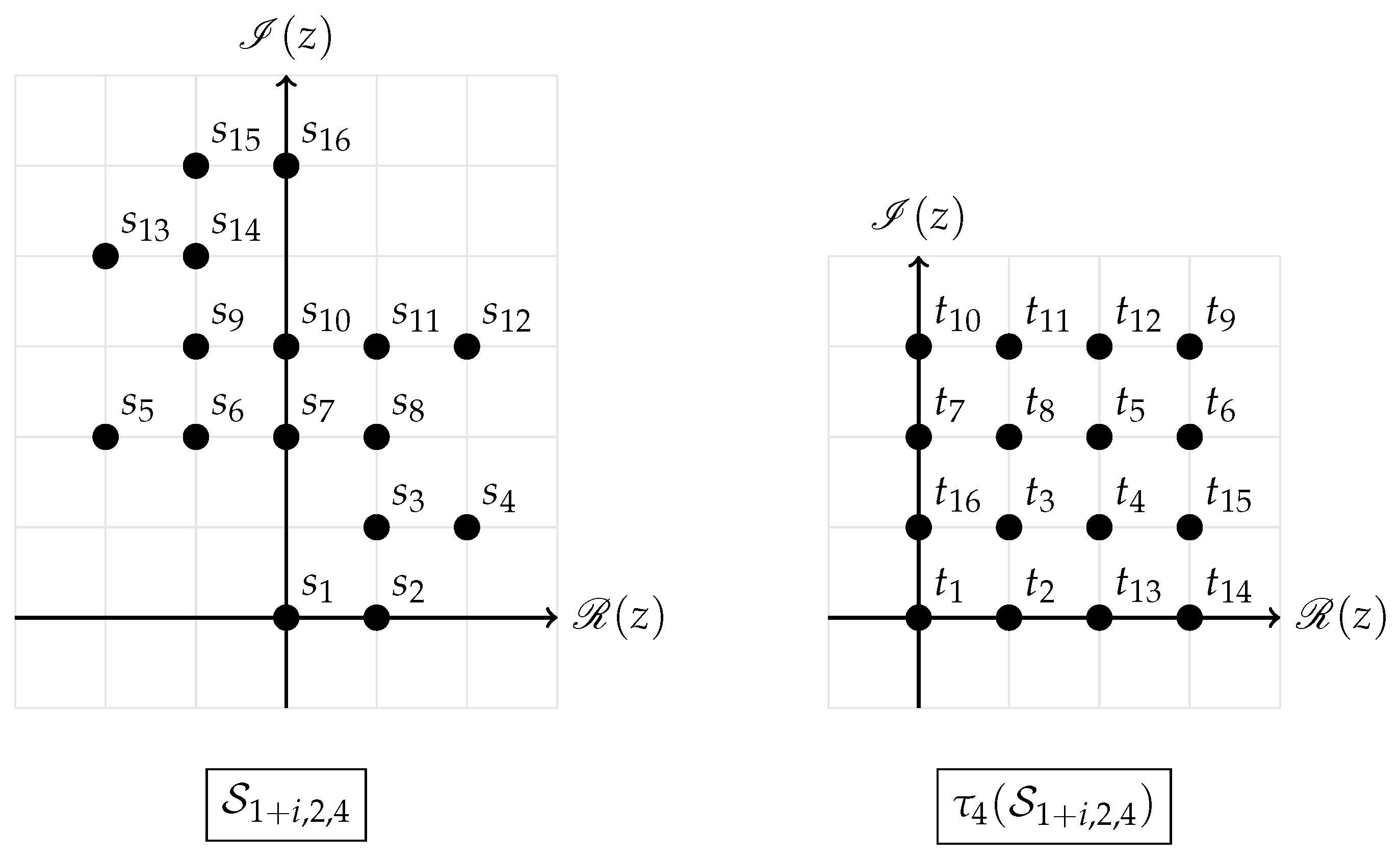
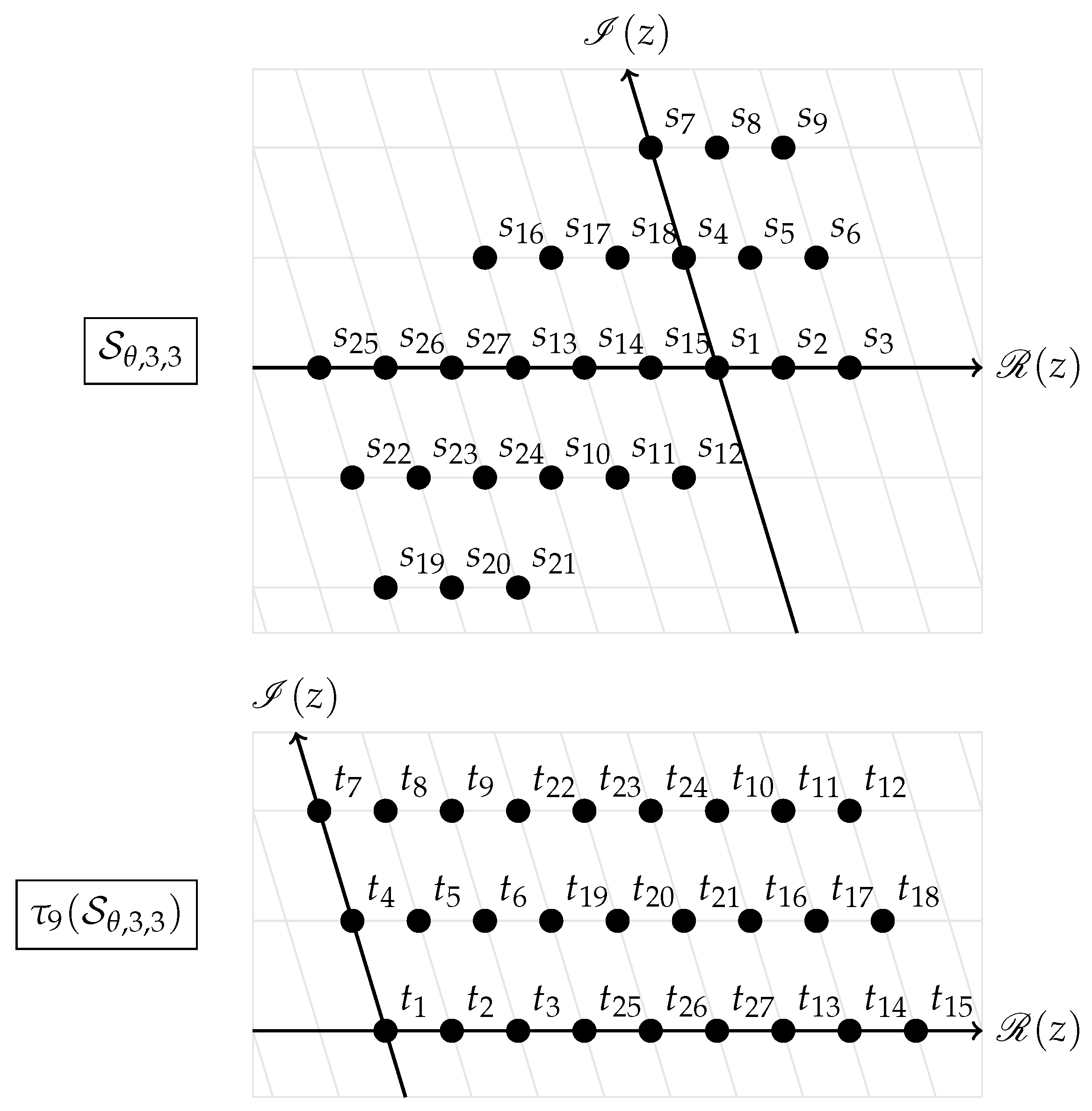
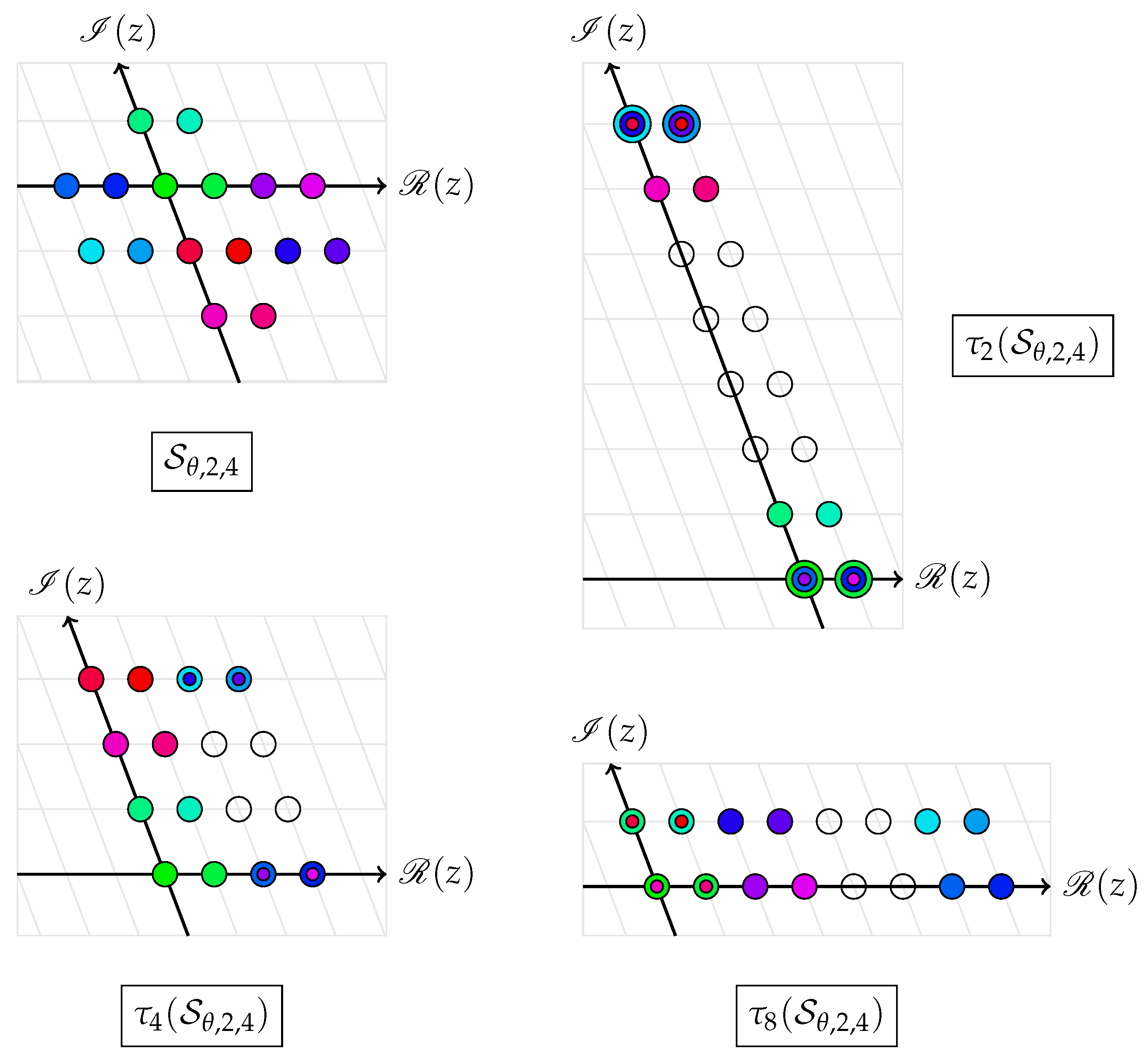
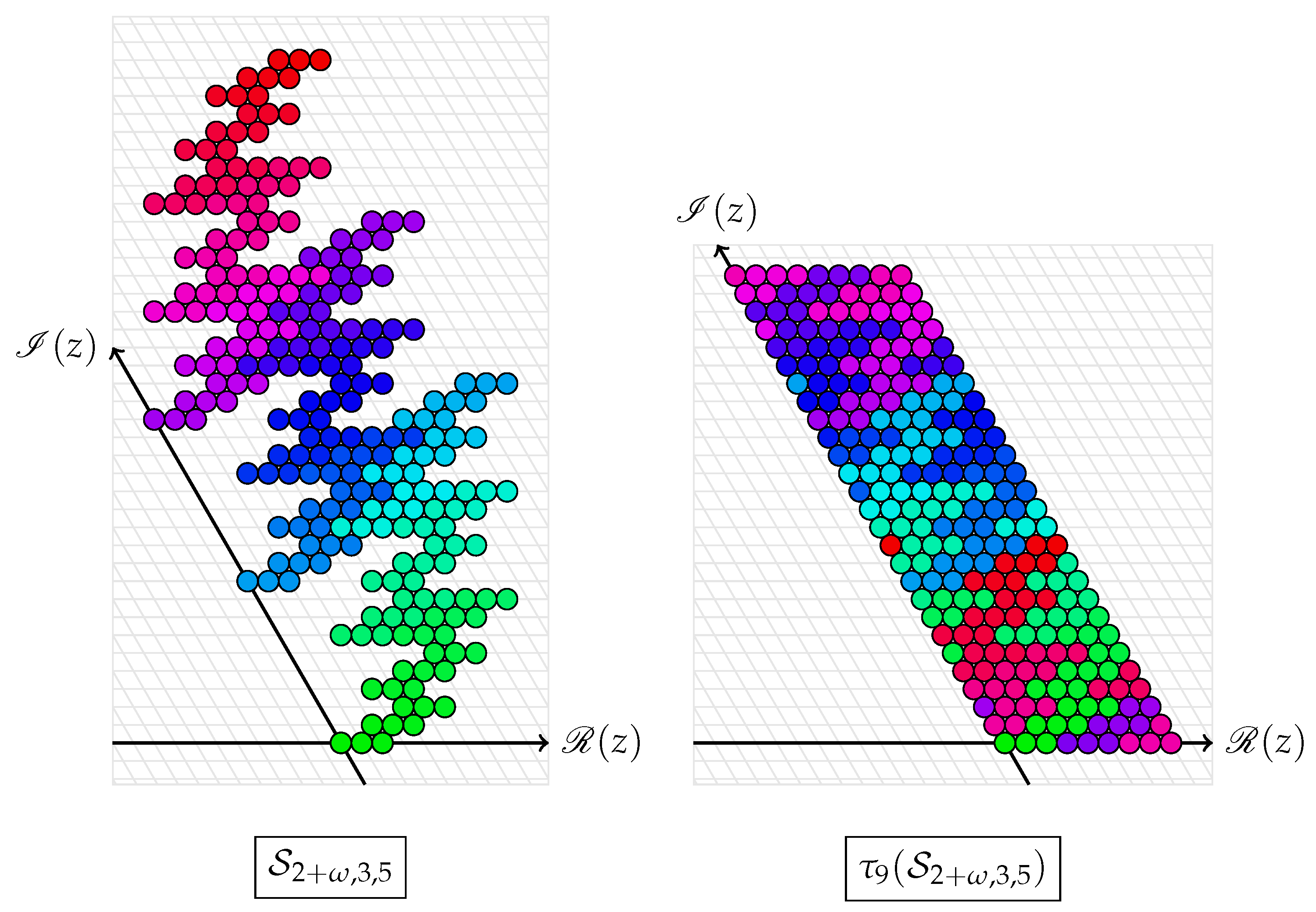
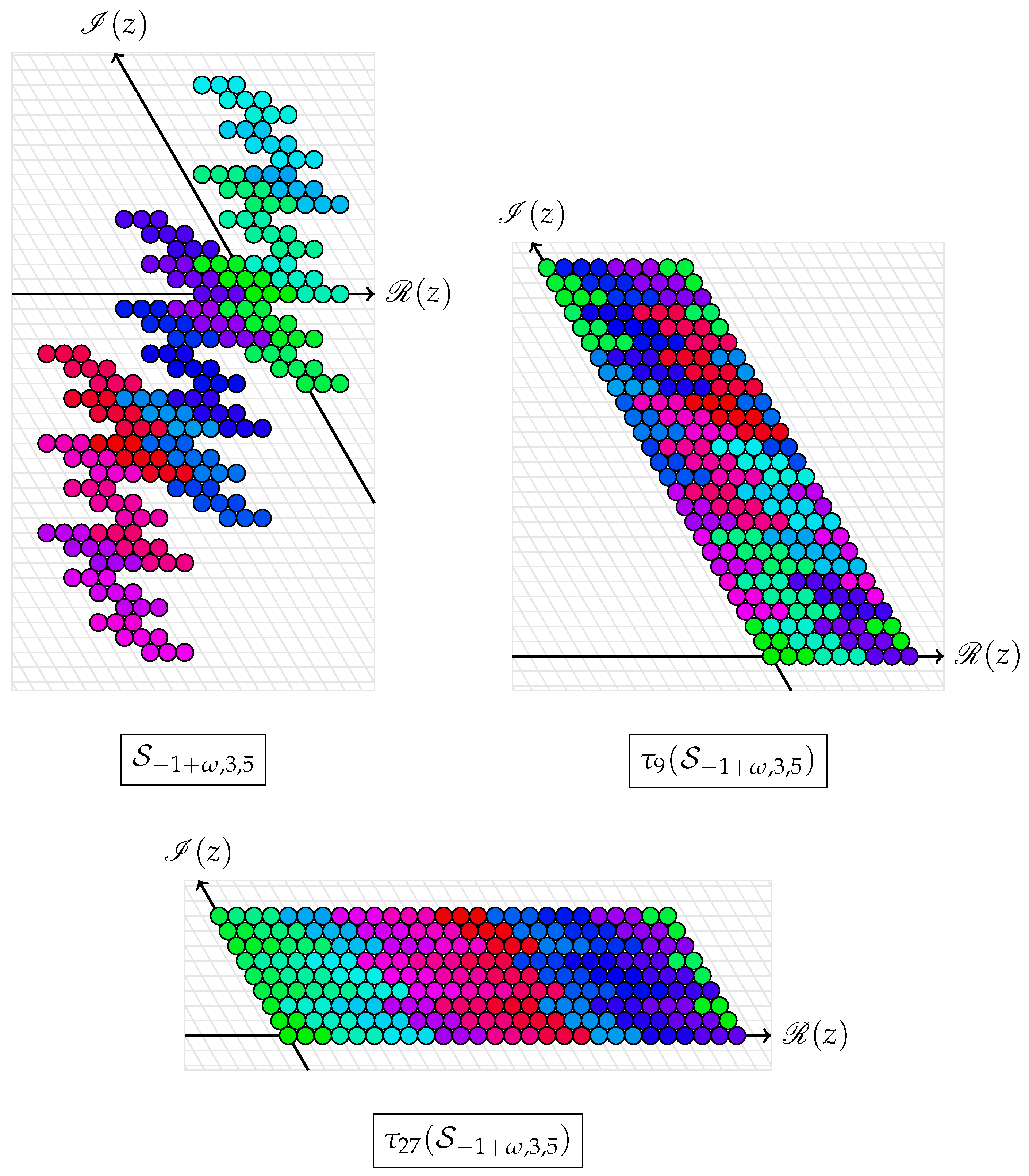
Disclaimer/Publisher’s Note: The statements, opinions and data contained in all publications are solely those of the individual author(s) and contributor(s) and not of MDPI and/or the editor(s). MDPI and/or the editor(s) disclaim responsibility for any injury to people or property resulting from any ideas, methods, instructions or products referred to in the content. |
© 2025 by the authors. Licensee MDPI, Basel, Switzerland. This article is an open access article distributed under the terms and conditions of the Creative Commons Attribution (CC BY) license (https://creativecommons.org/licenses/by/4.0/).
Share and Cite
Pooksombat, P.; Kositwattanarerk, W. Cubic Shaping of Lattice Constellations from Multi-Level Constructions from Codes. Mathematics 2025, 13, 1562. https://doi.org/10.3390/math13101562
Pooksombat P, Kositwattanarerk W. Cubic Shaping of Lattice Constellations from Multi-Level Constructions from Codes. Mathematics. 2025; 13(10):1562. https://doi.org/10.3390/math13101562
Chicago/Turabian StylePooksombat, Perathorn, and Wittawat Kositwattanarerk. 2025. "Cubic Shaping of Lattice Constellations from Multi-Level Constructions from Codes" Mathematics 13, no. 10: 1562. https://doi.org/10.3390/math13101562
APA StylePooksombat, P., & Kositwattanarerk, W. (2025). Cubic Shaping of Lattice Constellations from Multi-Level Constructions from Codes. Mathematics, 13(10), 1562. https://doi.org/10.3390/math13101562





